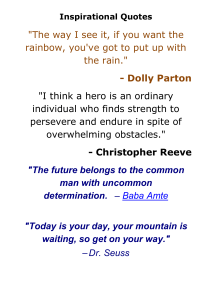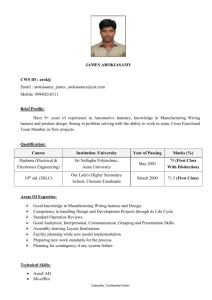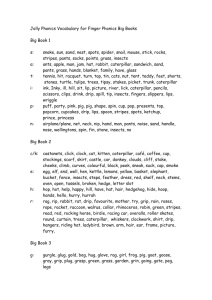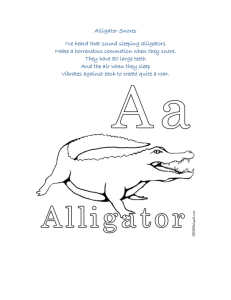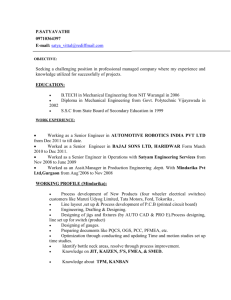Caterpillar - The Alternative Report
advertisement
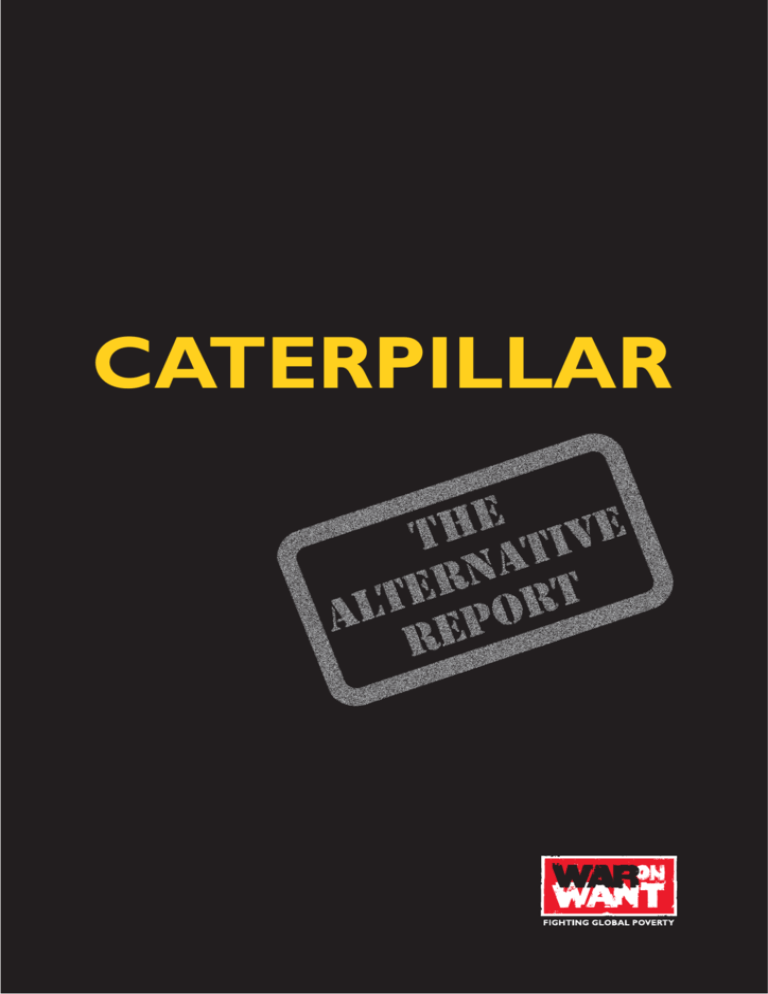
CATERPILLAR Caterpillar Inc. Chairman & CEO Employees worldwide Sales and revenues (2004) Profits (2004) Total assets Branch stores and retail outlets Subsidiaries Jim Owens 93,229 $30.3 billion $2.0 billion $36.4 billion 3,000 in 180 countries FG Wilson, MaK, Perkins, Solar Caterpillar UK Ltd UK employees 16 facilities 10,000 Caterpillar and its wholly owned UK subsidiaries have 10 offices in the UK: Caterpillar (UK) Building Construction Products, Leicester Perkins Engines, Peterborough Caterpillar Defence Products UK and Perkins Engines, Shrewsbury Perkins Engines, Stafford Caterpillar Logistics Services, Desford FG Wilson, Larne FG Wilson, Monkstown/ Springvale Caterpillar, Peterlee Turner Powertrain Systems,Wolverhampton Caterpillar Electronic & Electrical Systems, Peterborough Caterpillar website: www.cat.com Caterpillar military products: www.catdfp.com UK dealer: www.finning.co.uk Introduction This is the first in a new series of War on Want alternative company reports.Their purpose is to compare and contrast the rhetoric of corporate social responsibility (CSR) with the reality of companies’ actual practices.The reports form part of War on Want’s ongoing campaign for a global framework of corporate regulation, and each recommends action that ordinary people can take to rein in the power of multinational corporations across the world. This report looks at the international construction company Caterpillar, and in particular its operations in the Occupied Palestinian Territories. Caterpillar is the largest UK employer in the earth moving and construction industry, and is known on the high street for its range of rugged boots and fashion accessories.As a company, Caterpillar claims to maintain “a strong focus on social responsibility”, while its Code of Worldwide Business Conduct boasts “high ethical standards” through which Caterpillar should “set an example for others to follow”. Yet Caterpillar’s armoured bulldozers have been responsible for the destruction of thousands of Palestinian homes, schools, wells and olive groves. Caterpillar’s bulldozers have also been used in the construction of the Separation Wall which Israel has built on Palestinian land and which has been ruled illegal by the International Court of Justice.As a result of this involvement in the abuse of Palestinians’ human rights, Caterpillar has been subject to unprecedented criticism from the United Nations and international human rights groups. This report not only reviews Caterpillar’s record over and against its rhetoric on corporate social responsibility. It also recommends action, both to send a message to Caterpillar and to redress some of the damage inflicted on the Palestinian people through the company’s involvement.This is War on Want’s mission more widely: to support people in developing countries in their fight against the root causes of poverty, but also to inform and inspire people in rich countries to challenge the global structures which sustain poverty across the world. Louise Richards Chief Executive,War on Want CATERPILLAR: THE ALTERNATIVE REPORT 1 Caterpillar Bulldozers in Palestine “We are doing well by ‘doing good’ all around the world.” Jim Owens, Caterpillar Chairman & CEO Caterpillar is a global corporation, with its headquarters in Illinois, USA.According to its corporate literature it is the world’s largest manufacturer of construction and mining equipment, yet its machinery has also been used in military operations over several decades. From the Vietnam War onwards, Caterpillar’s bulldozers have been used for land clearance and other military purposes. Indeed, the bulldozers have become the company’s single most recognisable product. Caterpillar’s bulldozers have been used by the Israeli military since its occupation of the Palestinian Territories in 1967.Their use has come to international public attention in three major incidents: (i) the destruction of the Jenin refugee camp in April 2002 during Operation Defensive Shield; (ii) the killing of peace activist Rachel Corrie in March 2003; and (iii) the destruction of homes, roads and agricultural land in Rafah during Operation Rainbow in May 2004. Caterpillar bulldozers have also been used in clearing ground and demolishing buildings for the construction of Israel’s illegal Separation Wall, over 100 miles of which (out of a projected total of 450 miles) have already been built. The context: Israel’s military occupation of the Palestinian Territories Israel occupied the Palestinian Territories of the West Bank and Gaza Strip in October 1967, and has now maintained its military occupation of the territories for over 37 years.This is despite UN Security Council resolution 242 of 22 November 1967 calling for the withdrawal of Israeli armed forces from the territories, a call which has been reiterated by the UN on a regular basis ever since. Since September 2000, Israel has intensified its action against Palestinians living under the occupation, leading to a human rights crisis.According to the Israeli human rights centre B’Tselem, a total of 3,189 Palestinians were killed from September 2000 to the end of 2004, including 617 children; this is against 940 Israelis killed in the same period, including 167 children. In addition, 5,794 Palestinians – including 373 children – were being held in Israeli custody at the end of 2004, of whom 863 were being held without charge or trial, and with no release date. 2 CATERPILLAR: THE ALTERNATIVE REPORT Caterpillar’s bulldozers are currently used in almost every significant operation by Israeli forces in the Occupied Palestinian Territories. According to one Israeli military commander, Caterpillar bulldozers are “the key weapon”.1 D9s, the most commonly used bulldozer, have been used extensively in house demolitions, the destruction of Palestinian infrastructure and agricultural land, and in urban warfare support.The Israeli army currently has around 100 D9s in operation. The Caterpillar D9 weighs 53.8 tons, with a height of 3.96m and length of 8.13m.This makes it as tall as a double decker bus and as heavy as a tank. Powered by a 410horsepower engine, it can easily demolish a house, orchard or olive grove.The D9’s primary weapons are a front-fitted blade and a rear ‘ripper’ blade intended for use in loosening ground. Once supplied by Caterpillar, the bulldozers are modified by Israeli Military Industries, a state-owned Israeli arms manufacturer, and Israel Aircraft Industries’ Ramta division. Some bulldozers have customised packages including machine gun mounts, smoke projectors and grenade launchers. In addition, the Israeli army uses three types of Caterpillar Wheel Loaders, which are also modified in Israel for military purposes.2 Reports of 16 armoured Caterpillar D9s being used in Iraq shows that lessons from the Occupied Palestinian Territories are being employed in other conflict zones.3 Caterpillar D9 bulldozers in Palestine Photo: Reuters/Gil Cohen Magen Demolition of Homes, Farms and Land “We believe that our success should also contribute to the quality of life and the prosperity of communities.” Caterpillar’s Code of Worldwide Business Conduct, p12 According to the UN, a total of 4,170 Palestinian homes were destroyed by the Israeli army between September 2000 and December 2004.4 The Israeli Committee Against House Demolitions states that Israel has demolished almost 12,000 Palestinian homes since 1967, leaving some 70,000 people without shelter and traumatised.5 The Caterpillar D9 is the main tool used by the Israeli military to demolish homes, infrastructure and agricultural land in the Occupied Palestinian Territories. The usual reason given by the Israeli authorities for demolitions has been punitive action against the family homes of Palestinians engaged or suspected of engagement in armed activities against Israel. Even if true, this practice is illegal under international humanitarian law, as all destruction of property which is not rendered absolutely necessary by military operations is a breach of Article 53 of the Fourth Geneva Convention (to which Israel is a party).Yet a recent B’Tselem report cited by the UN shows that 47% of houses destroyed by the Israeli military were never home to anyone suspected of involvement in attacks upon Israelis.6 In May 2004, the UN Special Rapporteur on the Right to Food, Jean Ziegler, wrote to Caterpillar’s Chief Executive Jim Owens to express his concern that the Israeli army was “using armoured bulldozers supplied by your company to destroy agricultural farms, greenhouses, ancient olive groves and 4 agricultural fields planted with crops, as well as numerous Palestinian homes and sometimes human lives” (see p10 for more on this letter). The Israeli military has also destroyed hundreds of public buildings and commercial properties in the Occupied Palestinian Territories over the past four years, as well as vast areas of agricultural land. During a period of just two weeks from 29 March to 11 April 2002, 11 Palestinian schools were completely destroyed and nine more vandalised.7 Agriculture is the only source of livelihood for most Palestinians. Caterpillar bulldozers have uprooted extensive areas of cultivated land, including hundreds of thousands of olive, citrus and other trees, crops and vegetables. Olive trees in particular need many years to grow before they become productive, so destruction of olive groves has significant and far-reaching consequences for Palestinian livelihoods.The period between October 2000 and December 2001 alone saw the destruction of 454,541 trees.8 Hundreds of wells, water storage pools, tanks and electrical water pumps have also been destroyed, severely limiting access to drinking water.The irrigation network has also been severely damaged. During the Israeli army’s major assault on the Rafah refugee camp in the Gaza Strip in May 2004 (see p7), damage to water and sewage networks caused by the ‘ripper’ blade of the Caterpillar D9 meant that drinking water became contaminated with sewage.9 CATERPILLAR: THE ALTERNATIVE REPORT The Palestinian economy has been brought to the verge of collapse as a result of Israel’s occupation, and is now propped up only by external aid.The demolition of homes and the systematic destruction of land and infrastructure have formed an integral part of the economic warfare waged against the Palestinians, and have driven the Palestinian people deep into poverty. The UN lists the following among the direct causes of the humanitarian crisis facing the Palestinian people:10 • Israel’s confiscation and clearance of thousands of acres of the most fertile Palestinian land in order to build its illegal Separation Wall • the destruction of further Palestinian agricultural land and water resources for the construction of Israeli settler colonies and ‘settler only’ roads • the systematic destruction of Palestinian homes, olive groves and water systems in repeated assaults by the Israeli armed forces Caterpillar’s bulldozers have been employed in these actions, and the company bears its share of responsibility for the humanitarian crisis which has ensued. Caterpillar D9 demolishing buildings in Rafah Photo: Khalil Hamra/UNRWA The Battle of Jenin “We avoid those who violate the law or fail to comply with the sound business practices we promote.” Caterpillar’s Worldwide Code of Business Conduct, p7 Israeli soldier on 75-hour rampage with Caterpillar D9 In a unique interview in Yediot Aharonot, Israel’s most popular tabloid newspaper, on 31 May 2002, the Caterpillar D9 operator Moshe Nissim recounted his 75-hour long rampage in Jenin: I had no mercy for anybody. I would erase anyone with the D9 ...When I was told to bring down a house, I took the opportunity to bring down some more houses...They were warned by loudspeaker to get out of the house before I came, but I gave no one a chance. I didn’t wait. I didn’t give one blow and wait for them to come out. I would just ram the house with full power, to bring it down as fast as possible.11 The bulldozer unit was cited for outstanding service for its role in the operation. One of the most widely reported episodes in the intensified Israeli assault on the Palestinians over the past four years was the Battle of Jenin in April 2002. Caterpillar bulldozers were a key weapon in this action. Jenin is a densely populated refugee camp, home to 14,000 people.The camp became a central battleground in Operation Defensive Shield, an Israeli military operation which saw the “most extensive and severe” human rights violations since the occupation began in 1967, according to Israeli human rights centre B’Tselem.12 Based on eyewitness accounts, Human Rights Watch catalogued the extensive use of armoured bulldozers in house demolitions until well after the fighting had ended.13 By the end of the incursion, the entire Hawashin district of the camp had been levelled, down to the last house. Many 6 residents were given no notice before their houses were demolished. In cases where notice was given, it was often too late. People could not leave their houses because of the intense gunfire outside. Many were buried alive under the ruins; while some were subsequently rescued, others were not. Fathiya Suliman, aged 70, recounted how her house was demolished with her 38 year old son Jamal, who was deaf and paraplegic, still inside: We went into the house, but the operator of the bulldozer wouldn’t wait even one minute so that we could take Jamal out of the house... We rushed in while the bulldozer was already eating away at the house...The house began to collapse, and we ran for our lives.The house was completely destroyed with Jamal underneath.14 CATERPILLAR: THE ALTERNATIVE REPORT Razing Rafah In May 2004, Caterpillar bulldozers were used in the Israeli army’s assault on the refugee camp of Rafah, in the Gaza Strip. Code-named Operation Rainbow and lasting for the week of 18 to 24 May, the attack left 43 dead, including several children. John Dugard, UN Special Rapporteur on human rights in the Occupied Palestinian Territories, accused the Israeli military of grave breaches of the Fourth Geneva Convention during this assault. In his August 2004 report to the UN General Assembly, Dugard noted: Homes have been destroyed in a purely purposeless manner. Bulldozers have savagely dug up roads, including electricity, sewage and water lines, in a brutal display of power… The time has come for the international community to identify those responsible for this savage destruction of property and to take the necessary legal action against them.15 Human Rights Watch singled out the role of Caterpillar D9s in the systematic destruction of homes in Rafah in its report Razing Rafah: Mass Home Demolitions in the Gaza Strip. According to the report, the Israeli military “used Caterpillar D9s to indiscriminately tear up roads, destroying water and sewage networks, and creating a significant public health risk in an already vulnerable community”.16 In total 298 houses were destroyed, more than in any other month since September 2000. Rafah is one of the most densely populated places on earth, and many of the residents were dispossessed for a second or third time. Despite the provision of funds for rebuilding, there is insufficient land available in the Gaza Strip so construction has not gone ahead. In addition to the house demolitions, bulldozers razed 30 hectares of agricultural land filled with greenhouses for fruit, flowers and vegetables.The Israeli military tore up 51% of Rafah’s roads by dragging the Caterpillar D9 ‘ripper’ blades along the middle of the roads.17 The death of Rachel Corrie Rachel Corrie, a 23 year old American peace activist, was killed by a Caterpillar D9 bulldozer on 16 March 2003 as she stood in front of a Palestinian home in Rafah in an attempt to prevent its demolition. Rachel was in Gaza as a volunteer with the International Solidarity Movement (ISM). For a period of two hours she and other activists attempted to prevent the demolitions by physically blocking the passage of two bulldozers. Other ISM activists who were with her said the driver of the bulldozer was aware that Rachel was there but continued to destroy the house. She was wearing a bright orange jacket and using a loudhailer. Initially the driver dropped sand and other debris on her, but then the D9 pushed her to the ground and proceeded to drive over her, fracturing her arms, legs and skull. She was taken to hospital and pronounced dead shortly afterwards. CATERPILLAR: THE ALTERNATIVE REPORT 7 Israel’s Separation Wall “Caterpillar’s reputation for integrity is a fundamental part of our heritage… the values we believe in, the high ethical standards we live by…” Caterpillar’s Code of Worldwide Business Conduct, p3 Caterpillar’s bulldozers are currently involved in one of the most controversial Israeli acts of recent years: the construction of the illegal Separation Wall.The Wall extends deep into Palestinian territory and has destroyed the livelihoods of those Palestinians who now find themselves living along its route. John Dugard, UN Special Rapporteur on human rights in the Occupied Palestinian Territories, notes that the Wall has cut off Palestinians from their schools, universities, fields, hospitals, families and friends, with restrictions on movement which closely resemble the ‘pass laws’ of apartheid South Africa.18 The Separation Wall is set to be 450 miles long when completed, and around 125 miles have already been built.The Wall’s structure is part barbed wire, part electrified metal and part concrete wall up to 8 metres in height, with watchtowers and sniper positions every few hundred metres.To create space for the wall and the buffer zones which spread out on either side of it, agricultural land must be cleared and property destroyed – which is where Caterpillar comes in. Caterpillar bulldozers and earth movers are involved in the project to construct the The ICJ rules Israel’s Separation Wall illegal On 9 July 2004 the International Court of Justice (ICJ) – the UN’s highest judicial body – ruled that Israel’s Separation Wall is illegal.The ICJ demanded that construction of the Wall be halted and those sections already built be dismantled, along with compensation for Palestinians affected by the Wall. On 20 July 2004 the UN General Assembly voted overwhelmingly to demand that Israel abide by the ICJ’s ruling. The ICJ has also demanded that the international community take action to halt the Wall’s construction.All states which are party to the Fourth Geneva Convention are obliged to ensure Israel’s compliance with the Convention, and there is now a growing international movement calling for economic sanctions against Israel in order to force it to comply with its legal obligations. Equally, it is incumbent upon all governments to restrain corporations such as Caterpillar which are involved in the Wall’s construction. For more information on the Separation Wall go to www.nowall.org.uk 8 CATERPILLAR: THE ALTERNATIVE REPORT Separation Wall.19 The US-based Investor Responsibility Research Center, in a special report on Caterpillar in March 2004, confirmed that Caterpillar bulldozers “have been used to clear tracts of land for the new separation barrier”.20 The impact of these land clearances is deeply traumatic for the communities which undergo them. In one such incident from October 2004, the two West Bank villages of Dir AlAsal Al-Foqa and Dir Al-Asal Al-Tihta saw their olive groves destroyed by armoured Israeli bulldozers: Military bulldozers uprooted hundreds of olive trees after besieging the two villages and barring the owners of the fields from reaching them.... the lands are fertile and are considered the only source of living to tens of families in the village.21 Caterpillar D9 in cleared land Photo: Reuters/Popperfoto CATERPILLAR: THE ALTERNATIVE REPORT In an earlier report from January 2003, the Palestine Monitor reported that bulldozers were set to “destroy the entire village of AlDaba’ in the Qalqilya district.... Sixty ton American made armored Caterpillar D9 bulldozers will make short work of 42 houses, 600-700 dunums of agricultural land, a mosque, and an elementary school for 132 children.”22 Israel claims that the Separation Wall is a ‘security barrier’ designed to keep Palestinian militants out of Israel. John Dugard, UN Special Rapporteur on human rights in the Occupied Palestinian Territories, has rejected such claims, charging instead that the Wall is designed to incorporate Israeli settlers within its de facto border, to confiscate Palestinian land and to encourage an exodus of Palestinians by denying them access to their land and water resources and restricting their freedom of movement.23 9 Corporate Responsibility? “As a company and as individuals, we hold ourselves to the highest standard of integrity and ethical behavior… If we do any less, we put Caterpillar’s name and our reputation for integrity at risk.” Caterpillar’s Code of Worldwide Business Conduct, p4 Caterpillar’s Code of Worldwide Business Conduct boasts “high ethical standards” through which the company should “set an example for others to follow”.Yet the United Nations, international human rights groups and even Caterpillar’s own shareholders argue that the company is in serious breach of its own code of conduct through complicity in the violation of Palestinians’ human rights. How much responsibility does Caterpillar have for the end use of its bulldozers? Caterpillar agrees that the company has to act responsibly and ethically, but argues that it cannot be held responsible for the end use of its machines.As Caterpillar CEO Jim Owens put it in a letter to Kevin Clark of the International Solidarity Movement: We share your compassion for families that have suffered loss of life throughout the Middle East. Nevertheless, the fact remains that with more than two million of our Caterpillar excavator in Jayyous Photo: Donald Bostrom 10 machines and engines in use throughout the world, we simply do not have the practical ability or legal right to determine how our products are used after they are sold.24 Yet Caterpillar is fully aware of how its products are being used in Palestine. Indeed, in April 2004 a group of Caterpillar’s own shareholders introduced a resolution criticising the end use of the company’s products.The resolution questioned “whether Caterpillar’s directors can reconcile acquiescence” to the Israeli army’s use of the equipment against civilians with the company’s Code of Worldwide Business Conduct. Noting the negative “public relations costs” to Caterpillar of its involvement in the Israeli military’s operations, the resolution called on Caterpillar directors to establish an external inquiry into the company’s role in Palestine. In an unprecedented engagement with a nonstate actor, UN Special Rapporteur Jean Ziegler wrote to Jim Owens in May 2004 expressing his concern at Caterpillar’s involvement in Palestine: I am deeply concerned about the actions of the Israeli occupying forces in Rafah and in other locations in Gaza and the West Bank, using armoured bulldozers supplied by your company to destroy agricultural farms, greenhouses, ancient olive groves and agricultural fields planted with crops, as well as numerous Palestinian homes and sometimes CATERPILLAR: THE ALTERNATIVE REPORT human lives, including that of the American peace activist, Rachel Corrie. The letter focuses in particular on the violation of Palestinians’ right to food as enshrined in the International Covenant on Economic, Social and Cultural Rights.While states are party to the Covenant and ultimately accountable for compliance with it, the letter makes explicit that the private business sector has its own responsibilities in ensuring the right to food. It continues: In this context, there is also a concern that allowing the delivery of your D-9 and D-10 Caterpillar bulldozers to the Israeli army through the Government of the United States in the certain knowledge that they are being used for such actions, might involve complicity or acceptance on the part of your company to actual and potential violations of human rights, including the right to food. Despite this unprecedented charge of possible complicity in human rights violations, Caterpillar has not replied to the UN Special Rapporteur’s letter. In addition, it has failed to provide information on the “urgent measures” which the letter says the company must take to address the concerns. Caterpillar’s military links Caterpillar openly advertises the use of its bulldozers and excavators in military conflicts such as Iraq,Afghanistan and Bosnia.25 Its website states that its products are available to US and foreign military forces, and that the company has developed new bulldozers specifically for military purposes, including a new modified D7.The Israeli military recently ordered 25 Caterpillar D9 armoured bulldozers reinforced by Israel Aircraft Industries, while the US Department of Defense acquired 14 armoured Caterpillar D9Rs from the Israeli army for use in Operation Enduring Freedom in Iraq. Caterpillar products have also been exhibited at arms fairs including Defence Systems and Equipment International in London (DSEi) and Eurosatory in Paris.The UK Ministry of Defence awarded two contracts to Caterpillar UK Ltd in 2001 and 2000, worth £20£50 million.26 Caterpillar is also the direct beneficiary of US government assistance programmes, given that Israel is the number one recipient of US military assistance and 75% of that aid must be spent on US companies. In a letter sent to US campaign group Jewish Voice for Peace in August 2003, Caterpillar CEO Jim Owens confirmed that the company’s bulldozers are sold to Israel through the US Foreign Military Sales Program.As Jewish Voice for Peace notes,“Caterpillar bulldozers are not given to Israel as construction equipment but explicitly as weapons.”27 Or, in the words of Middle East analyst Robert Fisk, the Caterpillar bulldozer which killed Rachel Corrie “was part of the regular US aid to Israel.”28 CATERPILLAR: THE ALTERNATIVE REPORT 11 Take Action “Caterpillar’s commitment to social responsibility ensures our ability to meet today’s needs without sacrificing the ability to meet the needs of future generations.” Caterpillar ‘At a Glance’ War on Want believes that companies must be brought to account for complicity in human rights abuses.Yet the UK government prefers to support the voluntary approach of ‘corporate social responsibility’, despite the fact that this has been shown to be an ineffective alternative to regulation.As long as the political will to rein in corporate power is lacking in our elected leaders, it is up to us to apply pressure.We are asking all readers and supporters to take the following actions: 1. Boycott Caterpillar. Caterpillar doesn’t just produce construction equipment; it also sells both footwear and clothing in the UK, as well as other merchandise such as miniature Caterpillar vehicles, watches, mugs, bags and stationery (see inside back cover). Don’t buy these products – and tell your friends and family to follow suit. 2.Tell Caterpillar to stop supplying its bulldozers to the Israeli military. Write to Jim Owens, Chairman and CEO of Caterpillar, calling on him to suspend all sales of Caterpillar D9s to Israel for as long as they are employed in the violation of Palestinian rights. His address: James W Owens, Caterpillar Inc, 100 NE Adams St, Peoria, IL 61629-1425, USA; or email him: owens_james_w@cat.com 3. Call on the UK government to state its support for a binding framework of corporate accountability to regulate the activities of 12 companies such as Caterpillar. Please write to Rt Hon Jack Straw MP, Secretary of State for Foreign and Commonwealth Affairs, Foreign and Commonwealth Office, King Charles Street, London SW1A 2AH, calling on the government to abandon its promotion of voluntary alternatives and support binding corporate regulation instead. 4. Buy Zaytoun fairtrade olive oil and help undo the damage caused by Caterpillar’s bulldozers. Zaytoun is a UKbased non-profit project to purchase pesticide-free extra virgin olive oil from Palestinian farmers at fair trade prices. Olive oil is the backbone of the Palestinian agricultural economy, but over half of the country’s olive harvest goes unsold and spoils. For more information go to www.zaytoun.org or email: order@zaytoun.org Follow War on Want’s campaigns at: www.waronwant.org/palestine and www.nowall.org.uk. Also: • Caterkiller website, with links to the UK campaigns: www.caterkiller.org • Stop Caterpillar website: www.catdestroyshomes.org • Stop the Wall website, run by Palestinian NGO network: www.stopthewall.org CATERPILLAR: THE ALTERNATIVE REPORT Caterpillar merchandise In the UK, the licence for Caterpillar boots and shoes is held by London-based company Wolverine Europe Ltd (who also manufacture them, both in Europe and the USA) – see www.wolverineworldwide.com The boots are stocked by a wide range of retail outlets including Dolcis, Barratts, River Island, Jade, Schuh, John Lewis.You can find your nearest licensed retailer at: www.catfootwear.co.uk/docs/locate_uk.htm The Manchester-based company Pan-World Brands Ltd designs and markets Caterpillar branded clothing everywhere except North America.The clothing is stocked by major high street retailers such as River Island. For the full product range visit Caterpillar’s website: http://www.cat.com/cda/layout?m=37821&x=7 Notes 1. Alon Ben David, ‘Israel – Double Jeopardy’, Jane’s Defence Weekly, 17/11/04 2. Data from Israeli Aircraft Industries, Jane’s Armour and Artillery Upgrades, Jane’s Military Vehicles and Logistics and the Israeli Weapons website (www.israeliweapons.com) 3. Tom Sawyer & Andrew Wright, ‘Battlefield Commanders Review Lessons From Iraq’, Engineering News Record, 22/9/03 15. Report of the Special Rapporteur of the Commission on Human Rights on the situation of human rights in the Palestinian territories occupied by Israel since 1967. UN Doc A/59/256, 12 August 2004 16. Human Rights Watch, Razing Rafah: Mass Home Demolitions in the Gaza Strip (October 2004) 17. ibid. 4. Report of the Special Rapporteur of the Commission on Human Rights, John Dugard, on the situation of human rights in the Palestinian territories occupied by Israel since 1967. UN Doc E/CN.4/2005/29, 7 December 2004 18. Report of the Special Rapporteur of the Commission on Human Rights on the situation of human rights in the Palestinian territories occupied by Israel since 1967. UN Doc A/59/256, 12 August 2004 5. ICAHD Campaign Against House Demolitions; http://www.icahd.org/eng/campaigns.asp?menu=4&submenu=2 19. Emad Mekay, ‘Shareholders Drive Probe on Caterpillar’s Israel Sales’, Inter Press Service, 12/04/04 6. B’Tselem, Through No Fault of Their Own: Israel’s Punitive House Demolitions in the al-Aqsa Intifada (November 2004) 20. Cited in University of Wisconsin System Trust Funds Investments and Social Responsibility, Caterpillar and Human Rights in Israel (December 2004) 7. War on Want, Fighting Palestinian Poverty: A survey of the economic and social impact of the Israeli occupation on the Palestinians in the West Bank and Gaza Strip (June 2003) 21. Saed Bannoura, ‘Hundreds of dunams bulldozed near Hebron’, International Middle East Media Center, 10/10/04 8. ibid. 23. Report of the Special Rapporteur of the Commission on Human Rights on the situation of human rights in the Palestinian territories occupied by Israel since 1967. UN Doc A/59/256, 12 August 2004 9. Human Rights Watch, Razing Rafah: Mass Home Demolitions in the Gaza Strip (October 2004) 10. The right to food: Report by the Special Rapporteur, Jean Ziegler; Addendum: Mission to the Occupied Palestinian Territories. UN Doc E/CN.4/2004/10/Add.2, 31 October 2003 11. Tsadok Yeheskeli, ‘I made them a stadium in the middle of the camp’, originally published in Yediot Aharonot 31/5/2002; republished in full on Gush Shalom website: http://www.gush-shalom.org/archives/kurdi_eng.html 12. B’Tselem, Operation Defensive Shield: Soldiers’ Testimonies, Palestinian Testimonies (September 2002), p3 13. Human Rights Watch, Jenin: IDF Military Operations (May 2002) 14. B’Tselem, Operation Defensive Shield: Soldiers’ Testimonies, Palestinian Testimonies (September 2002), p15 22. ‘Palestinian village faces annihilation’, Palestine Monitor, 14/01/03 24. Letter from Caterpillar CEO Jim Owens to the International Solidarity Movement, dated 19/04/04; available online at: www.catdestroyshomes.org 25. e.g. on the Armed Forces International website: http://www.armedforcesint.com/article.asp?pubID=15&catID=466&artID=702 26. MoD UK Defence Statistics Reports, 2001 and 2002 27. Liat Weingart, Sister Valerie Heinonen and Mary Ann McGivern, ‘Caterpillar’s Choice’, Zmag, 20/04/04 28. Robert Fisk, ‘War Lords to Their Critics: “Just Shut Up”’, The Independent, 04/10/04 Published March 2005 War on Want War on Want is a UK-based campaigning charity. Founded in 1951 it has links to the labour movement and supports progressive, people-centred Written by War on Want based on research development projects around the world. War on Want campaigns in the by Joe Zacune and Claire Fauset. UK against the causes of world poverty. War on Want Fenner Brockway House 37-39 Great Guildford Street London SE1 0ES Tel: + 44 (0)20 7620 1111 Fax: +44 (0)20 7261 9291 E-mail: mailroom@waronwant.org www.waronwant.org Company limited by guarantee reg No 629916. Charity No. 208724
